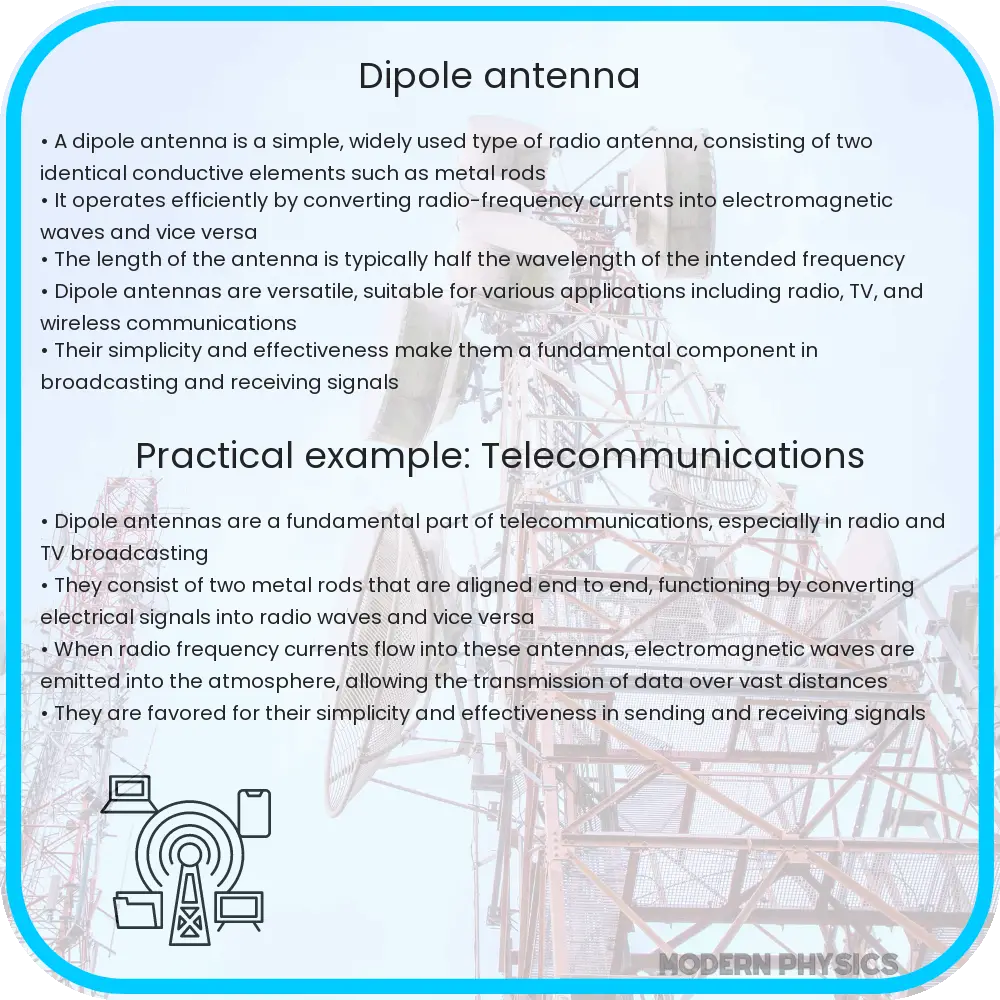Explore the design, range, and electrodynamics of dipole antennas, from basic principles to advanced configurations in wireless communications.

Dipole Antenna: An Overview
The dipole antenna is a simple yet fundamental type of antenna that is widely used in radio and telecommunications. Its basic design consists of two conductive elements such as metal wires or rods, which are typically half a wavelength long. This simplicity makes it not only a popular choice for various applications but also an ideal starting point for understanding the principles of antenna design and electromagnetics.
Design and Functioning of a Dipole Antenna
At its core, a dipole antenna operates by converting electrical energy into electromagnetic waves and vice versa. This process is governed by Maxwell’s equations, which describe how electric and magnetic fields interact. The antenna is usually fed at the center, which divides it into two sections. When an alternating current passes through these sections, it creates a standing wave pattern, leading to the radiation of electromagnetic waves into the surrounding space.
Key Parameters of Dipole Antenna
The performance of a dipole antenna is determined by several factors:
- Length: The length of the antenna is critical and is typically half the wavelength (λ/2) of the frequency it is designed to transmit or receive. This length ensures that the antenna operates at its resonant frequency, where it is most efficient.
- Material: The conductive material used affects the antenna’s efficiency and bandwidth. Common materials include copper, aluminum, and sometimes silver for high-performance applications.
- Impedance: The impedance of the antenna should match that of the transmission line to minimize reflections and maximize power transfer. For a standard half-wave dipole, the impedance is approximately 73 ohms.
Range and Applications
The range of a dipole antenna depends on several factors, including its height above the ground, the surrounding environment, and the frequency of operation. In general, higher frequencies allow for shorter antennas but have more limited range. Dipole antennas find use in a myriad of applications, from basic AM radio receivers to more complex systems like satellite communications and wireless networks.
In summary, the dipole antenna’s simple design belies its importance and versatility in the field of wireless communication. Understanding its basic principles provides a solid foundation for exploring more advanced antenna designs and radio wave propagation.
Electrodynamics of a Dipole Antenna
The functioning of a dipole antenna is deeply rooted in electrodynamics. When an alternating current flows through the antenna, it creates a time-varying electric field. This changing electric field, in turn, produces a magnetic field, as per Faraday’s law of induction. The interaction between these electric and magnetic fields results in the generation of electromagnetic waves, which propagate away from the antenna.
The radiation pattern of a dipole antenna is typically bidirectional, forming a figure-eight pattern in the plane perpendicular to the length of the antenna. The intensity of the radiated signal varies with the angle from the antenna, being strongest at right angles to the antenna and zero along its axis.
Optimizing Dipole Antenna Performance
To maximize the performance of a dipole antenna, certain aspects must be considered:
- Height above Ground: Raising the antenna above the ground can reduce ground reflection losses and enhance its effective range.
- Orientation: Aligning the antenna properly with respect to the direction of the desired signal can significantly improve reception.
- Environment: The antenna’s surroundings, including nearby buildings and foliage, can affect its performance due to obstructions and reflections.
Advanced Dipole Configurations
Beyond the basic half-wave design, various modifications can be made to enhance specific characteristics of a dipole antenna:
- Folded Dipole: Increases the antenna’s impedance, useful for matching it to higher impedance transmission lines.
- Multiband Dipole: Designed to operate efficiently over multiple frequency bands.
- Directional Dipoles: By adding elements, such as reflectors or directors, a dipole antenna can be made more directional, focusing its power in specific directions.
Conclusion
The dipole antenna, with its inherent simplicity and efficiency, plays a crucial role in the world of wireless communications. From its basic operating principles rooted in electrodynamics to its various advanced configurations, the dipole antenna exemplifies the intricate relationship between electrical engineering and electromagnetic theory. As technology progresses, the dipole antenna continues to evolve, adapting to new frequencies and applications while maintaining its status as a fundamental building block in the field of antenna design.
